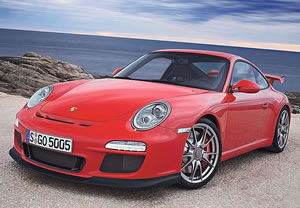Porsche account books still doing well
01 Apr 2009|2,480 views
 |
Although operating results at Porsche dropped in line with the development of turnover, the operating margin generated is still in double digits. Increased development costs, inter alia for the Gran Turismo Panamera and for the hybrid drive of the Cayenne, had a negative effect. Up to January 5, 2009, the date on which Volkswagen was fully consolidated in the consolidated accounts of Porsche SE, the VW results attributable to Porsche amounted to exactly EUR 444.4 million, as compared with EUR 483.9 million in the previous year. For January 2009, the income statement of VW could not be reflected in the income statement of Porsche SE. The reason for this is the different accounting reference date of Volkswagen AG.
According to the final figures, turnover at Porsche fell in the first half-year by 12.8 per cent to EUR 3.04 billion. Sales decreased by 26.7 per cent to 34,266 units. The substantially better development in turnover compared to the development in sales is primarily due to a changed model mix. Whereas a higher share of the overall sales is attributable to the 911 series, the share of the Boxster series has fallen considerably. Sales of the 911 series amounted to 13,543 vehicles (16,261 in the previous year) and, in the case of the mid-engine sports car, to 3,950 units (9,835 vehicles in the previous year). The Cayenne achieved sales of 16,773 vehicles (20,638 in the previous year).
For the second half of the 2008/09 business year, Porsche is pinning its hopes on the new Boxster and Cayman models, with more powerful and, at the same time, substantially more fuel-efficient engines, and on the Cayenne Diesel. All of these vehicles have been available since February 2009 and have generated significant interest from customers.
Overall, Porsche feels well prepared as regards its product offering. Despite the crisis on the financial markets and the very difficult economic conditions, Porsche SE managed to conclude a new loan in the amount of EUR ten billion at the end of March 2009, which was used to repay the existing loan in the same amount. It has been agreed with the consortium banks that an additional amount of up to EUR 2.5 billion may - and therefore the volume that Porsche originally has planned - be raised from further banks within a specified period on the basis of the loan agreement. The proposed increase of the loan is intended to support the achievement of strategic goals and also to meet future capital requirements.
Furthermore, Porsche intends to obtain a credit rating from two internationally recognised agencies. The company believes that this will further improve its refinancing possibilities.
 |
Although operating results at Porsche dropped in line with the development of turnover, the operating margin generated is still in double digits. Increased development costs, inter alia for the Gran Turismo Panamera and for the hybrid drive of the Cayenne, had a negative effect. Up to January 5, 2009, the date on which Volkswagen was fully consolidated in the consolidated accounts of Porsche SE, the VW results attributable to Porsche amounted to exactly EUR 444.4 million, as compared with EUR 483.9 million in the previous year. For January 2009, the income statement of VW could not be reflected in the income statement of Porsche SE. The reason for this is the different accounting reference date of Volkswagen AG.
According to the final figures, turnover at Porsche fell in the first half-year by 12.8 per cent to EUR 3.04 billion. Sales decreased by 26.7 per cent to 34,266 units. The substantially better development in turnover compared to the development in sales is primarily due to a changed model mix. Whereas a higher share of the overall sales is attributable to the 911 series, the share of the Boxster series has fallen considerably. Sales of the 911 series amounted to 13,543 vehicles (16,261 in the previous year) and, in the case of the mid-engine sports car, to 3,950 units (9,835 vehicles in the previous year). The Cayenne achieved sales of 16,773 vehicles (20,638 in the previous year).
For the second half of the 2008/09 business year, Porsche is pinning its hopes on the new Boxster and Cayman models, with more powerful and, at the same time, substantially more fuel-efficient engines, and on the Cayenne Diesel. All of these vehicles have been available since February 2009 and have generated significant interest from customers.
Overall, Porsche feels well prepared as regards its product offering. Despite the crisis on the financial markets and the very difficult economic conditions, Porsche SE managed to conclude a new loan in the amount of EUR ten billion at the end of March 2009, which was used to repay the existing loan in the same amount. It has been agreed with the consortium banks that an additional amount of up to EUR 2.5 billion may - and therefore the volume that Porsche originally has planned - be raised from further banks within a specified period on the basis of the loan agreement. The proposed increase of the loan is intended to support the achievement of strategic goals and also to meet future capital requirements.
Furthermore, Porsche intends to obtain a credit rating from two internationally recognised agencies. The company believes that this will further improve its refinancing possibilities.
Latest COE Prices
December 2025 | 1st BIDDING
NEXT TENDER: 17 Dec 2025
CAT A$105,413
CAT B$123,900
CAT C$76,501
CAT E$123,000
View Full Results Thank You For Your Subscription.
















